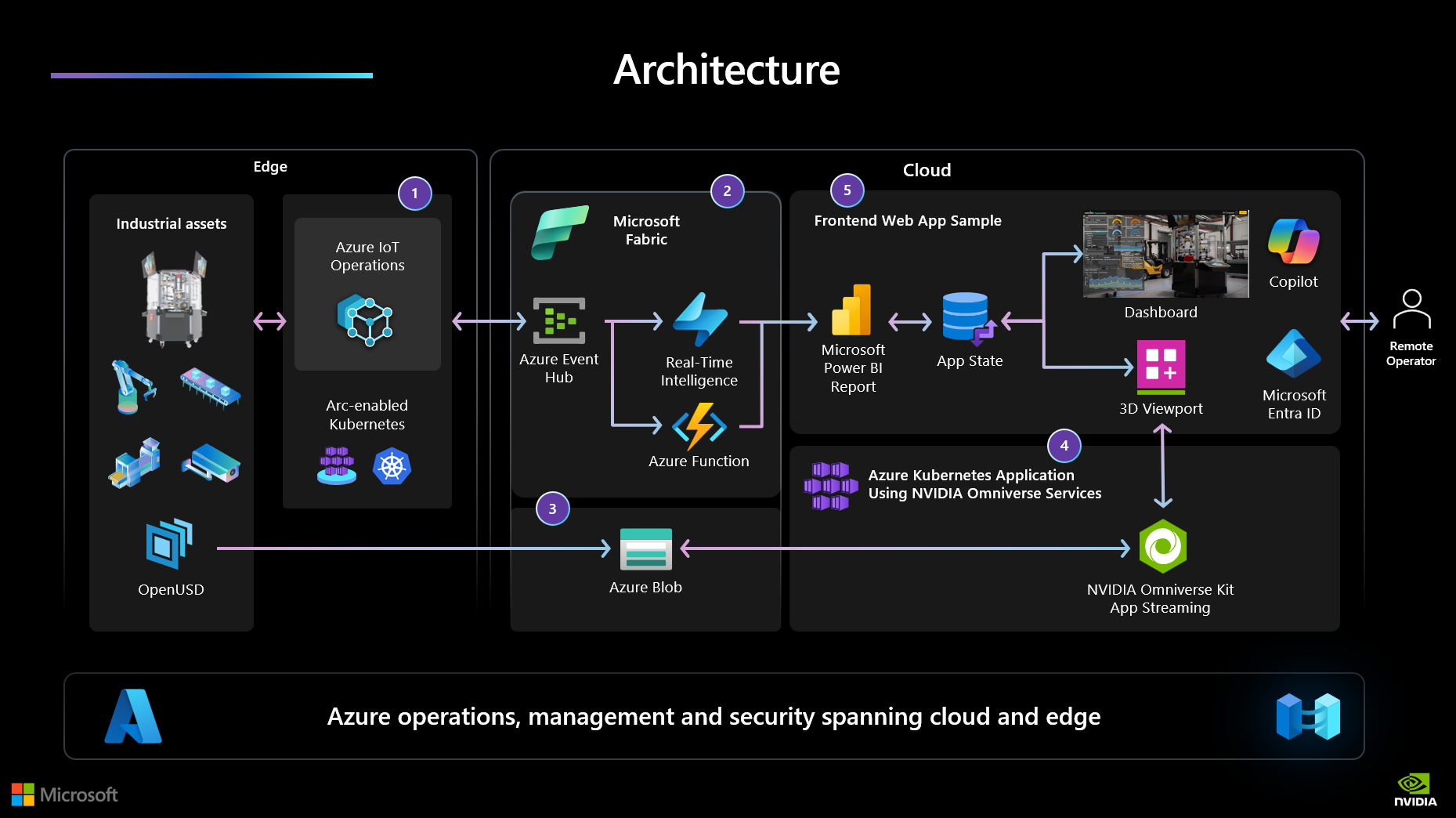As enterprises increasingly integrate AI into their industrial operations to deliver more automated and autonomous facilities, more operations teams are becoming centralized in remote operations centers. From these centers, these teams monitor, operate, and provide expert guidance to distributed production sites.
A new generation of 3D remote monitoring solutions, powered by advancements in computer graphics, accelerated computing, and open standards like Universal Scene Description (OpenUSD), are emerging to transform industrial operations by removing silos between IT and operational technology. This enables operations experts to quickly identify and solve problems, simulate operations at scale, and optimize production.
To help developers build advanced, AI-enabled 3D applications and workflows to support operations teams, NVIDIA and Microsoft Azure have developed a reference architecture, Microsoft Azure Arc Jumpstart guide, and a public GitHub repo. These resources guide developers step by step in how to connect physically accurate 3D models of industrial systems and production environments to real-time data from Azure IoT Operations and Power BI reports.
From 2D to 3D remote monitoring of industrial operations
Traditionally, operations teams have monitored industrial systems and facilities through 2D dashboards and data visualizations, which can make it challenging to fully contextualize operational data and the complex relationships between factory equipment, processes, and workflows.
With the advancements in computer graphics and generative AI, operations teams are embracing more interactive and intuitive tools, including physically accurate 3D digital twins and simulation environments that provide deeper insights into systems and facilities, resulting in accelerated decisions and outcomes.
When these AI-enabled 3D solutions are connected to live data at the edge, they unlock many benefits for enterprises and remote monitoring teams, including:
- Accelerated problem identification and decisions: By analyzing live production data alongside 3D visualizations, operators can quickly identify operational issues and inefficiencies in equipment, production lines, and processes and surface new opportunities for improving safety and sustainability.
- Real-time collaboration: Regardless of where they are physically located, interdisciplinary teams can use shared 3D environments to collaborate in real time and gain access to new data and insights.
- Simulation and scenario planning: Operators can use 3D environments and operational data to train and refine AI models, simulate the impact of various scenarios such as equipment failures, and test potential solutions and production changes before implementing them in the real world.
Building a new era of 3D remote monitoring solutions
Developers looking to deliver benefits like these to enterprises and their remote operations teams can reference the Azure Arc Jumpstart guide and microsoft/NVIDIA-Omniverse-Azure-Operations-Twin GitHub repo to learn how to build 3D remote monitoring applications and workflows powered by Azure IoT Operations, Power BI, OpenUSD, and NVIDIA Omniverse Kit App Streaming.
The Azure Arc Jumpstart guides developers through a series of foundational steps to build an end-to-end workflow for 3D remote monitoring, including:
- Azure IoT edge telemetry orchestration (plant floor, smart buildings)
- Telemetry data stream contextualization through Azure Data Explorer
- Digital models (USD assets) management in Azure BLOB storage
- Scene rendering and application streaming with Omniverse Kit App Streaming
- Interactive operations digital twin composed of embedded 3D viewport with Power BI reports and analytics

The reference workflow and Azure Arc Jumpstart guide demonstrate how dynamic IoT data from the factory floor can be used to update a Power BI report that is integrated with an OpenUSD-based application developed on the NVIDIA Omniverse platform.
Using the guide, developers learn how to connect IoT data to the Power Platform and how to build a web application embedding an Omniverse powered 3D viewport and Power BI visuals. This enables you to build an end user experience that provides real-time production data in the context of a physically accurate 3D visualization.
The guide details deployment of Kit-based applications via Omniverse Kit App Streaming on the Azure Kubernetes Service (AKS), enabling horizontal scaling of NVIDIA RTX GPU-accelerated compute resources to remote operators.
You’re encouraged to customize the reference web application and the embedded 3D viewport for your desired use cases and workflows.
Get started
To get started developing applications and workflows on Microsoft Azure IoT Operations and NVIDIA Omniverse to transform your industrial operations, check out these resources: